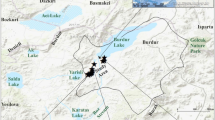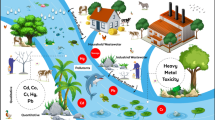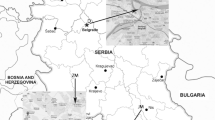Abstract
The water quality of Owan river, a very important river in Ovia North-East Local Government Area of Edo State, Nigeria was assessed. American Public Health Association (APHA) standard analytical procedures for water and sediment samples were used. Elemental composition of the sediment samples were determined by Energy Dispersive X-ray Fluorescence Spectrometer (EDXRF). Results obtained were statistically analysed (basic descriptive). In water, concentrations (mg/L) of nitrate—(2.65–21.55), sulphate—(58.6–80.0), calcium —(3.21–8.60), dissolved oxygen (5.5–6.53), total hardness (12.60–42.0), alkalinity (32.0–50.5), Cd (0.01), Cr (0.1–0.15), As (0.01–0.05), and Zn (1.4–2.04), electrical conductivity (32.0–38.0 µS/cm) and pH (6.10–6.85) were within environmental standards. However, Fe and Pb were slightly above the standards. In the sediment samples, Al, Si, Fe, and K are the most abundant elements. The highest values were detected as follows: Al—8.09 (SW7), Si—25.08 (SW5), Fe—16.72 (SW6), and K—2.1 (SW7). Urgent checks and monitoring by relevant agencies, government representatives, public health practitioners, and community leaders are required.



Similar content being viewed by others
Data availability statement
The data presented in this study are available on request from the corresponding author.
Change history
17 September 2021
A Correction to this paper has been published: https://doi.org/10.1007/s42108-021-00148-y
Abbreviations
- PTEs:
-
Potentially toxic elements
- TM:
-
Trace metals
- NSDWQ:
-
Nigerian Standard for Drinking Water Quality
- USEPA:
-
United States Environmental Protection Agency
- BOD:
-
Biochemical oxygen demand
- COD:
-
Chemical oxygen demand
- NTU:
-
Nephelometric turbidity unit
- DO:
-
Dissolved oxygen
- WHO:
-
World Health Organisation
- WS:
-
Water sample
- TDS:
-
Total dissolved salts/solids
- EC:
-
Electrical conductivities
References
Abulude, F. O., Adebiyi, A. B., & Elemide, O. A. (2019). Physico-Chemical Parameters of Rainwater samples obtained in a Suburban Town in Ondo State, Nigeria. Continental Journal Environmental Sciences, 12(1), 21–38. https://doi.org/10.5281/zenodo.3575244
Akinnusotu, A., Abulude, F. O., & Abdulrasheed, Y. (2015). Determination of Physico-chemical Properties and Metal concentrations of hand dug wells around a dumpsite in Akure, Ondo State, Nigeria. Continental Journal Environmental Sciences, 9(2), 22–36.
Akinnusotu, A., & Arawande, J. O. (2016). Qualities of Effluents from three Cocoa Processing factories in Ondo State, Nigeria. International Journal of Environment and Bioenergy, 11(1), 24–35.
APHA. (1998). Standard methods for the examination of water and wastewater (20th ed.). American Public Health Association.
Aremu, M. O., Olaofe, O., Ikokoh, P. P., & Yakubu, M. M. (2011). Physicochemi-cal characteristics of stream, well and borehole water sources in Eggon, Nasarawa State, Nigeria. Journal Chemical Society of Nigeria, 36(1), 131–136.
Asamoah, A. A., & Amorin, B. S. (2011). Assessment of the quality of bottled sachet water in the Tarkwa-Nsuaem municipality in Ghana. Research Journal of Applied Science, 3(5), 105–113.
Asante, K. A., Quarcoopome, T. F., & Amevenku, Y. K. (2005). Water quality of the Weija reservoir after 28 years of impoundment. West African Journal of Applied Ecology, 13, 112–114.
Ayotunde, E. O., Offem, B. O., & Ada, F. B. (2012). Heavy metal profile of water, sediment and freshwater cat fish, Chrysichthys nigrodigitatus (Siluriformes: Bagridae), of Cross River, Nigeria. Revista De Biología Tropical, 60(3), 1289–1301. https://doi.org/10.15517/rbt.v60i3.1807 PMID: 23025098.
Bruning-Fann, C. S., & Kanaeme, J. B. (1993). The effect of nitrate, nitrite, and N-nitro compound on human health. Veterinary and Human Toxicology, 35, 521–538.
Burton, G. A. (2017). Sediment toxicity assessment (1st ed.). CRC Press. https://doi.org/10.1201/9781351076555
Cambers, G., Muehlig-Hofmann, A., & Troost, D. (2008). Environment and development in coastal regions and in small Islands: a small Islands’ perspective. Accessed on 14th May, 2021. www.unesco.org/csi/wise/tenure.html.
Castiglioni, S., & Maier, J. A. M. (2011). Magnesium and cancer: A dangerous liason. Magnesium Research, 24(3), S92–S100. https://doi.org/10.1684/mrh.2011.0285
Daramola, J., Ekhwan, T. M., Adepehin, E. J., Mokhta, J., Lam, K. C., & Er, A. C. (2019). Seasonal quality variation and environmental risks associated with the consumption of surface water: Implication from the Landzun Stream, Bida Nigeria. Heliyon, 5, e02121. https://doi.org/10.1016/j.heliyon.2019.e02121
Edegbene, A. O., & Arimoro, F. O. (2014). Preponderance of Mollusca in Owan river, Niger Delta Area, Nigeria. Electronic Journal of Biosciences, 2(1), 67–76.
Edori and Iyama. (2020). Status of heavy metals contamination in water from Edagberi Creek, Engenni, Rivers State, South-South, Nigeria. Biomedical Journal of Science & Technological Research, 29(3), 22482–22488. https://doi.org/10.26717/BJSTR.2020.29.004810
EPA, (2018). Drinking Water Standards and Health Advisory Table. U.S. Environ-mental Protection Agency. https://www.epa.gov/sites/production/files/2018-03/documents/dwtable2018.pdf.
Farahat, E., & Linderholm, H. W. (2015). The effect of long-term wastewater irrigation on accumulation and transfer of heavy metals in Cupressus sempervirens leaves and adjacent soils. Science of the Total Environment., 512–513(9), 1–7. https://doi.org/10.1016/j.scitotenv.2015.01.032
Ghali, H., Osimen, E. C., Ogidiaka, E., Akamagwuna, F. C., Keke, U. N., & Edegbene, A. O. (2020). Preliminary assessment of the deteriorating state of a dam in north-westernNigeria using phytoplankton structural assemblage and environmental factors. Water Science, 34(1), 181–189. https://doi.org/10.1080/11104929.2020.1816152
Gorde, S. P., & Jadhav, M. V. (2013). Assessment of water quality parameters: A review. International Journal of Engineering Research and Applications., 3(6), 2029–2035.
Gosselin, R. E., Smith, R. P., & Hodge, H. C. (1984). Clinical toxicology of commercial products (5th ed.). Williams & Wilkins.
Igwe, O., Adepehin, E. J., Iwuanyanwu, C., & Una, C. O. (2014). Risks associated with the mining of Pb–Zn minerals in some parts of the Southern Benue trough, Nigeria. Environmental Monitoring and Assessment, 186, 3755–3765. https://doi.org/10.1007/s10661-014-3655-3
Irenosen, G. O., Egbulefu, A. V. I., & Korede, A. O. (2019). The Microbial status and physico-chemical pollutants studies of rivers Owan and Evbiobe in Edo State, Nigeria. Science Journal of Analytical Chemistry, 7(2), 57–64. https://doi.org/10.11648/j.sjac.20190702.13
Ivanić, M., Durn, G., Škapin, S. D., & Sondi, I. (2020). Size-related mineralogical and surface physicochemical properties of the mineral particles from the recent sediments of the Eastern Adriatic Sea. Chemosphere, 249, 126531.
Jaishankar, M., Tseten, T., Anbalagan, N., Mathew, B., & Beeregowda, K. (2014). Toxicity, mechanism and health effects of some heavy metals. Interdisciplinary Toxicology, 7(2), 60–72. https://doi.org/10.2478/intox-2014-0009
Lacey, R. F., & Shaper, A. G. (1984). Changes in water hardness and cardiovascular death rates. International Journal of Epidemiology, 13(1), 18–24. https://doi.org/10.1093/ije/13.1.18
Martin, S., & Griswold, W. (2009). Human health effects of heavy metals. Environmental Science and Technology Brief Citizens 15, 1–6. www.engg.ksu.edu/CHSR/ Accessed 14th May, 2021.
Meride, Y., & Ayenew, B. (2016). Drinking water quality assessment and its effects on residents health in Wondo genet campus, Ethiopia. Environmental System Research, 5, 1. https://doi.org/10.1186/s40068-016-0053-6
Mkadmi, Y., Benabbi, O., Fekhaoui, M., Benakkam, R., Bjijou, W., Elaz-zouzi, M., Kadourri, M., & Chetouani, A. (2018). Study of the impact of heavy metals and physico-chemical parameters on the quality of the wells and waters of the Holcim area (Oriental region of Morocco). Journal of Materials and Environmental Science, 9(2), 672–679.
Nazeer, S., Hashmi, M. Z., & Malik, R. S. (2014). Heavy metals distribution, risk assessment and water quality characterization by water quality index of the River Soan, Pakistan. Ecological Indicators, 43, 262–270. https://doi.org/10.1016/j.ecolind.2014.03.010
Nnorom, I. C., Ewuzie, U., & Eze, S. O. (2019). Multivariate statistical approach and water quality assessment of natural springs and other drinking water sources in Southeastern Nigeria. Heliyon, 5(2019), e01123. https://doi.org/10.1016/j.heliyon.2019.e01123
Ochelebe, I., Kudamnya, E. A., & Nkebem, G. E. (2020). An assessment of heavy metals concentration in water around quarries and Barite mine sites in part of central cross River State, Southeastern Nigeria. Global Journal of Geological Sciences, 18, 89–95. https://doi.org/10.4314/gjgs.v18i1.8
Omoigberale, M. O., Oboh, I. P., Erhunmwunse, N. O., Ezenwa, I. M., & Omoruyi, S. O. (2014). An assessment of the trace metal contents of Owan river, Edo State, Nigeria. European International Journal of Science and Technology, 3(5), 88–98.
Owamah, H. I., Asiagwu, A. K., Egboh, S. H. O., & Phil-Usiayo, S. (2013). Drinking water quality at Isoko North communities of the Niger Delta Region, Nigeria. Toxicological & Environmental Chemistry, 95(7), 1116–1128. https://doi.org/10.1080/02772248.2013.847939
Popoola, L. T., Yusuff, A. S., & Aderibigbe, T. A. (2019). Assessment of natural groundwater physico-chemical properties in major industrial and residential locations of Lagos metropolis. Applied Water Science, 9, 191. https://doi.org/10.1007/s13201-019-1073-y
Rahmanian, N., Ali, S. H. B., Homayoonfard, M., Ali, N. J., Rehan, M., Sadef, Y., & Nizami, A. S. (2015). Analysis of physiochemical parameters to evaluate the drinking water quality in the State of Perak, Malaysia. Journal of Chemistry. https://doi.org/10.1155/2015/716125
Raviprakash, S. L., & Krishna, R. G. (1989). The chemistry of groundwater Paravada area with regard to their suitability for domestic and Irrigation purpose. India Journal of Geochemistry, 4(1), 39–54.
Restuccio, A. (1992). Fatal hyperkalemia from a salt substitute. American Journal of Emergency Medicine, 10(2), 171–173. https://doi.org/10.1016/0735-6757(92)90058-6
Rose, L. A., Karwan, D. L., & Aufdenkampe, A. K. (2018). Sediment fingerprinting suggests differential suspended particulate matter formation and transport processes across hydrologic regimes. Journal of Geophysical Research: Biogeosciences, 123(4), 1213–1229.
Sengupta, P. (2013). Potential health impacts of hard water. International Journal of Preventive Medicine, 4(8), 866.
Sila, O. N. (2019). Physico-chemical and bacteriological quality of water sources in rural settings, a case study of Kenya, Africa. Scientific African, 2, e00018. https://doi.org/10.1016/j.sciaf.2018.e00018
Standard Organization of Nigeria (SON). (2007). Nigerian standards for drinking water quality (NSDWQ), Industrial standards. SON, 554, 1–14.
Sumant, K. N. C., Ghosh, R. P., Singh, M. M., Sonkusare, S. S., & Sanjay, M. (2015). Assessment of water quality of lakes for drinking and irrigation purposes in Raipur City, Chhattisgarh, India. International Journal of Engineering Research and Applications, 5, 42–49.
Talabi, A. O., Ojo, O. F., Ajayi, C. A., Olaolorun, O. A., & Afolagboye, O. L. (2016). Hydrochemistry and environmental status of river Owan water, Edo State Nigeria. International Journal of Environment and Pollution Research, 4(5), 1–15.
Trcek, B., & Zojer, H. (2010). Recharge of springs. In N. Kresic & Z. Stevanovic (Eds.), Groundwater hydrology of springs: Engineering, theory, management, and sustainability (pp. 87–127). Butterworth-Heinemann.
Ustaoglu, F., & Tepe, Y. (2019). Water quality and sediment contamination assessment of Pazarsuyu Stream, Turkey using multivariate statistical methods and pollution indicators. International Soil and Water Conservation Research, 7(1), 47–56. https://doi.org/10.1016/j.iswcr.2018.09.001
Verma, S., Mohanty, B. P., Singh, K. P., Behera, B. R., & Kumar, A. (2018). Dependence of recipitation of trace elements on pH in standard water. Nuclear Instruments and Methods in Physics Research Section b: Beam Interactions with Materials and Atoms, 420, 18–22. https://doi.org/10.1016/j.nimb.2018.01.016
WHO. (2007). Guidelines of drinking water quality (3rd ed.). World Health Organization.
WHO (2017). Guidelines for drinking-water quality, 4th edition, incorporating the 1st addendum. Overview. https://www.who.int/publications/i/item/9789241549950. Accessed 12th Jun 2021
WHO. (2018). A global overview of National regulations and standards for drinking water quality (p. 104). WHO.
Acknowledgements
The authors wish to acknowledge the contributions of the people who assisted in the collection of the samples and the anonymous reviewers.
Funding
The authors wish to thank Tertiary Education Trust Fund (TETFund) for the research grant received (TETFUND/DRSS/POLY/OWO/2016/RP/VOL 1) through Rufus Giwa Polytechnic, Owo, Nigeria to carry out this research project.
Author information
Authors and Affiliations
Corresponding author
Ethics declarations
Conflict of interest
The authors declare that they have no conflict of interest.
Institutional review board statement
Not applicable.
Informed consent statement
Not applicable.
Rights and permissions
About this article
Cite this article
Akinnusotu, A., Ukpebor, J.E., Okieimen, F.E. et al. Assessment of the physico-chemical characteristics and elemental properties of water and sediments from Owan river in Edo State, Nigeria. Int J Energ Water Res 6, 543–552 (2022). https://doi.org/10.1007/s42108-021-00144-2
Received:
Accepted:
Published:
Issue Date:
DOI: https://doi.org/10.1007/s42108-021-00144-2




